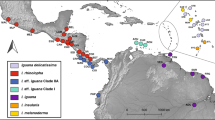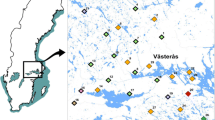Abstract
We contend that a recent study of microsatellite variation in invasive populations of the New Zealand mudsnail in the United States (Dybdahl and Drown 2011) underestimated genotypic diversity because it inappropriately focused on allelic size ranges that were previously documented for (invasive) British populations. The authors ignored peaks that were “far outside” of these size ranges, thus precluding recognition of additional alleles, including those that have been reported in other populations of this species. We are also concerned about the lack of reproducibility in the scoring methods utilized because the authors did not define a threshold for deciding when peaks should be ignored. The extent to which genotypic diversity consequently has been underestimated and otherwise inaccurately described cannot be ascertained based on the data provided in this study.

Similar content being viewed by others
References
Buonaccorsi VP, McDowell JR, Graves JE (2001) Reconciling patterns of inter-ocean molecular variance from four classes of molecular markers in blue marlin (Makaira nigricans). Mol Ecol 10:1179–1196
Comstock KE, Georgiadis N, Pecon-Slattery J, Roca AL, Ostrander EA, O’Brien SJ, Wasser SK (2002) Patterns of molecular genetic variation among African elephant populations. Mol Ecol 11:2489–2498
Di Rienzo A, Peterson AC, Garza JC, Valdes Am, Slatkin N, Freimer NB (1994) Mutational processes of simple-sequence repeat loci in human populations. Proc Natl Acad Sci 91:3166–3170
Dybdahl MF, Drown DM (2011) The absence of genotypic diversity in a successful parthenogenetic invader. Biol Invasions 13:1663–1672
Estoup A, Garnery L, Solignac M, Cornuet J-M (1995) Microsatellite variation in Honey Bee (Apis mellifera L.) populations: hierarchical genetic structure and test of the Infinite Allele and Stepwise Mutation Models. Genetics 140:679–695
Gibbs HL, Prior K, Parent C (1998) Characterization of DNA microsatellite loci from a threatened snake: the Eastern Massasauga rattlesnake (Sistrurus c. catenatus) and their use in population studies. J Hered 89:169–173
Hershler R, Liu H-P, Clark WH (2010) Microsatellite evidence of invasion and rapid spread of divergent New Zealand mudsnail (Potamopyrgus antipodarum) clones in the Snake River basin, Idaho, USA. Biol Invasions 12:1521–1532
MacAvoy ES, McGibbon LM, Sainsbury JP, Lawrence H, Wilson CA, Daugherty CH, Chambers GK (2007) Genetic variation in island populations of tuatara (Sphenodon spp) inferred from microsatellite markers. Conserv Genet 8:305–318
Neiman M, Lively CM (2004) Pleistocene glaciation is implicated in the phylogeographical structure of Potamopyrgus antipodarum, a New Zealand snail. Mol Ecol 13:3085–3098
Valdes AM, Slatkin M, Freimer NB (1993) Allele frequencies at microsatellite loci: the stepwise mutation model revisited. Genetics 133:737–749
Weetman D, Hauser L, Carvalho GR (2001) Isolation and characterization of di- and trinucleotide microsatellites in the freshwater snail Potamopyrgus antipodarum. Mol Ecol Notes 1:185–187
Weetman D, Hauser L, Carvalho GR (2002) Reconstruction of microsatellite mutation history reveals a strong and consistent deletion bias in invasive clonal snails, Potamopyrgus antipodarum. Genetics 162:813–822
Weetman D, Hauser L, Carvalho GR (2006) Heterogeneous evolution of microsatellites revealed by reconstruction of recent mutation history in an invasive apomictic snail, Potamopyrgus antipodarum. Genetica 127:285–293
Author information
Authors and Affiliations
Corresponding author
Rights and permissions
About this article
Cite this article
Hershler, R., Liu, HP. & Clark, W.H. Comments on “The absence of genotypic diversity in a successful parthenogenetic invader” by Mark Dybdahl and Devin Drown [Biological Invasions 13 (2011), 1663–1672]. Biol Invasions 14, 1643–1645 (2012). https://doi.org/10.1007/s10530-012-0184-2
Received:
Accepted:
Published:
Issue Date:
DOI: https://doi.org/10.1007/s10530-012-0184-2




